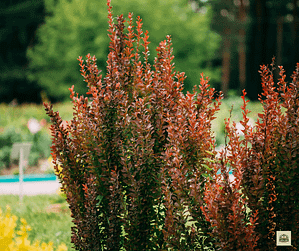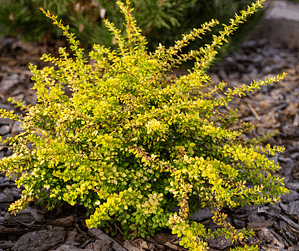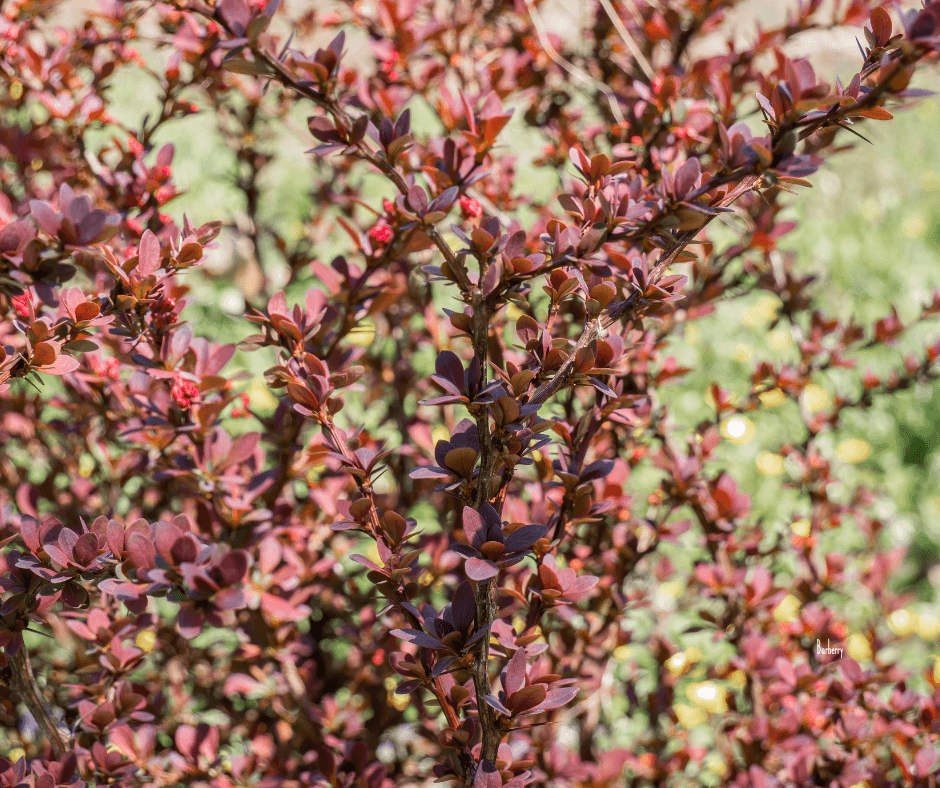Unmasking the Intruder: The Ultimate Guide to Japanese Barberry Identification
Japanese barberry is an invasive plant species that poses significant ecological challenges. Understanding how to accurately identify this plant is crucial for lawn and landscape professionals looking to maintain healthy green spaces. This comprehensive will walk you through the characteristics and identification techniques for Japanese barberry. Barberry identification can be tricky because they come in several colors and forms. They all have thorns, so that is the first thing to check.
Introduction to Japanese Barberry
Japanese barberry (Berberis thunbergii) is a stealth invader that has taken root across North America, transforming landscapes from coast to coast. Traditionally admired for its aesthetic appeal in ornamental gardening, this tenacious shrub has donned a nefarious mask, posing significant environmental challenges. Let's uncover the ins and outs of this invasive intruder, starting with what makes it so distinguishable—and problematic.
Originally native to Japan, this squat shrub was introduced to the U.S. in the 1800s for its decorative prowess. Fast forward to the present, and you'll find it thriving in forests, fields, and even your own backyard.
But not all that glitters is gold—or, in this case, crimson. Japanese barberry has a knack for outcompeting native plants, disrupting ecosystems, and creating a perfect habitat for disease-carrying ticks.
The USDA Forest Service says, "Japanese barberry infestations can lead to increased tick populations, as the dense foliage provides an ideal,... humidity-controlled micro-environment."
- Thrives in Various Conditions: This invasive species isn't picky. You'll find it in sunny fields, shady forests, and even urban settings.
- Prolific Reproduction: Japanese barberry produces abundant seeds, which birds happily disperse far and wide. Notably, one mature plant can produce thousands of seeds annually.
- Ecological Disruptor: By forming dense thickets, it elbows out native shrubs and understory plants, altering soil chemistry and compromising biodiversity.
- Human Health Risks: Studies indicate that Japanese barberry thickets can harbor higher densities of ticks, increasing the odds of Lyme disease transmission.
But it’s not all doom and gloom. Proper identification and proactive management can keep this invasive at bay. Let's equip you with the knowledge to unmask the Japanese barberry for what it truly is—a landscape intruder.
Characteristics of Japanese Barberry
Recognizing Japanese barberry involves understanding its distinct features. This plant is like the Sherlock Holmes of the invasive plant world—just way more persistent and way less British. Typically, it grows to about 2-8 feet in height and forms dense that can make you feel like you're navigating through an obstacle course in your backyard.
The leaves are small, oval, and usually 1 inch long. As fall rolls around, these leaf ninjas pull a beautiful trick: they turn vibrant shades of red, orange, and purple. Picture your backyard hosting a foliage festival.
Japanese barberry branches are brown to reddish-brown, and you’ll notice a singular spine at each node. Think of it as the plant’s way of giving a gentle yet prickly hug to anyone who dares touch it.
Flowers: In the spring, the plant produces small, pale yellow blooms. These blossoms might look delicate, but don't be fooled—they're part of an invasive powerhouse.
Berries: Come winter, Japanese barberry flaunts bright red, oblong berries that persist through the cold months, adding a pop of color when everything else is dull and gray. These berries are not just eye-candy; they are part of the plant's strategy to spread seeds far and wide via birds.
"Autumn...the year's last, loveliest smile," wrote William Cullen Bryant. If only he had known he was waxing poetic about invasive species!
How to Tell Them Apart By Foliage Color and Pattern
'Rose Glow': Look for the distinctive marbled pink, purple, and white variegation on new growth.
'Crimson Pygmy': Identified by its consistent deep crimson-red foliage.
'Golden Nugget': Notable for its bright golden-yellow leaves.
'Helmond Pillar': Deep purple leaves similar to 'Crimson Pygmy' but differs in growth habit.
'Aurea': Bright yellow to chartreuse foliage, which may gain a reddish hue.
1. 'Rose Glow' (Berberis thunbergii 'Rose Glow')
Foliage: Color: New leaves emerge as a striking rose pink mottled with deep purple and white. As the leaves mature, they turn a deep purplish-red.
Texture: Smooth, with a glossy appearance.
Size and Habit: Reaches about 4 to 5 feet in height and width.
Growth Habit: Upright and bushy, with arching branches.
Distinguishing Features: Notable for its variegated foliage with a marbled mix of pink, purple, and white, especially prominent on new growth. Produces small yellow flowers in spring, followed by bright red berries in fall.
2. 'Crimson Pygmy' (Berberis thunbergii 'Crimson Pygmy')
Foliage Color: Deep crimson to burgundy-red leaves throughout the growing season, retaining color well into fall.
Texture: Small, oval leaves with a slightly leathery feel.
Size and Habit: Compact dwarf variety growing about 2 to 3 feet tall and wide.
Growth Habit: Dense and rounded, forming a neat mound.
Distinguishing Features: Its dwarf size and consistent deep red foliage make it ideal for borders, rock gardens, and low hedges.May produce tiny yellow flowers and occasional red berries, though less prolific than larger varieties.
3. 'Golden Nugget' (Berberis thunbergii 'Golden Nugget')
Foliage Color: Vibrant golden-yellow leaves that can turn orange or red in the fall.
Texture: Small and fine-textured, adding a delicate appearance.
Size and Habit: Height and Spread: Very small, typically reaching only about 1 foot tall and wide.
Growth Habit: Dwarf and compact, with a slow growth rate.
Distinguishing Features: Among the smallest barberry varieties, making it perfect for rock gardens or edging. Its bright golden foliage adds a splash of color to the landscape, especially when contrasted with darker plants.
4. 'Helmond Pillar' (Berberis thunbergii 'Helmond Pillar')
Foliage Color: Deep purple to burgundy leaves that may turn brighter red in the fall.
Texture: Smooth leaves aligned closely along upright stems.
Height and Spread: Grows 4 to 5 feet tall but stays narrow, only about 1 to 2 feet wide.
Growth Habit: Columnar and upright, resembling a pillar.
Distinguishing Features: Unique vertical growth makes it stand out among other barberries, suitable for tight spaces or as an architectural element. Ideal for adding height without taking up much horizontal space.
5. 'Aurea' (Berberis thunbergii 'Aurea')
Foliage Color: Bright yellow to chartreuse leaves that can develop a slight reddish tint in full sun or in the fall.
Texture: Soft, with a velvety feel.
Height and Spread: Typically grows 3 to 4 feet tall and wide.
Growth Habit: Rounded and slightly spreading, with dense branching.
Distinguishing Features: The luminous yellow foliage illuminates garden spaces, especially effective in shaded areas where the color brightens darker corners. More tolerant of shade than other golden varieties, though color is best in full sun.
How To Identify Common Barberry Varieties
Foliage Color and Pattern:
'Rose Glow': Look for the distinctive marbled pink, purple, and white variegation on new growth.
'Crimson Pygmy': Identified by its consistent deep crimson-red foliage.
'Golden Nugget': Notable for its bright golden-yellow leaves.
'Helmond Pillar': Deep purple leaves similar to 'Crimson Pygmy' but differs in growth habit.
'Aurea': Bright yellow to chartreuse foliage, which may gain a reddish hue.
Size and Growth Habit:
'Rose Glow' and 'Aurea': Medium-sized shrubs with a bushy, rounded habit.
'Crimson Pygmy' and 'Golden Nugget': Dwarf varieties; 'Golden Nugget' is smaller.
'Helmond Pillar': Tall and narrow with a columnar form, unlike the spreading habit of others.
Unique Characteristics:
Variegation: Only 'Rose Glow' has variegated foliage with multiple colors on the same leaf.
Columnar Shape: 'Helmond Pillar' is the only one with a pillar-like growth.
Foliage Consistency: 'Crimson Pygmy' maintains its deep red color uniformly, while 'Aurea' and 'Golden Nugget' have yellow hues.
Seasonal Changes:
Fall Color: Many varieties intensify in color during autumn. For example, 'Helmond Pillar' may become brighter red.
Flowering and Fruiting:
Flowers: Small, pale yellow flowers appear in spring on all varieties but are more prominent on larger shrubs.
Berries: Bright red berries may follow in late summer to fall, especially on 'Rose Glow' and 'Aurea'.
Placement and Use in Landscaping:
Formal Hedges or Borders: 'Crimson Pygmy' and 'Golden Nugget' are excellent for low hedges.
Vertical Accent: Use 'Helmond Pillar' where vertical interest is needed.
Color Contrast: Pair 'Aurea' or 'Golden Nugget' with dark-leaved plants for striking contrast.
Specimen Planting: 'Rose Glow' serves well as a focal point due to its unique foliage.
Several states, including Massachusetts, Minnesota, Wisconsin, and others, have restrictions or bans on the sale and planting of Japanese barberry.
By understanding the key characteristics of these popular Japanese barberry varieties, you can select the right one for your garden and recognize them in the landscape.
Comparing Japanese Barberry to Native Barberry Species
Distinguishing between Japanese barberry (Berberis thunbergii) and native bar species is akin to telling apart Clark Kent and Superman – once you know the key differences, it's hard to mistake one for the other (though, unlike Superman, Japanese barberry isn’t here to save the day).
An effective control plan hinges on correct identification, as eradicating invasive Japanese barberry while preserving native species is essential for maintaining ecological balance.
Key Characteristics:
- Thicket Formation: Japanese barberry is notorious for forming dense thickets that are more reminiscent of a mini-forest party gone out of control. Native barberries, such as American barberry (Berberis canadensis), generally exhibit more modest growth, lacking the same aggressive thicket formation.
- Berries: Japanese barberry’s berries are persistent, bright red, and can often be seen hanging on even in winter, like those holiday lights you forgot to take down. Native barberries produce berries too, but they tend to be less plentiful and not as tenacious.
- Thorns: Though both types brandish thorns, Japanese barberry thorns are usually thinner and more numerous. Imagine running into a patch of nature’s barbed wire – that's Japanese barberry for you!
- Leaf Shape and Color: The leaves of Japanese barberry are small, oval, and typically green during the growing season, turning an attractive red or orange in the fall. Native barberries can also have similar seasonal colors, but often bear larger, more rounded leaves.
The ability of Japanese barberry to withstand harsh conditions and spread rapidly has led researchers to classify it as a highly invasive species. According to the USDA, this invasive nature allows it to outcompete many native plants.
"It's essential to control Japanese barberry to preserve our native landscapes," says Dr. John Smith, an ecologist at the University of Natural Sciences. "The differences might seem subtle at first, but with practice, identification becomes straightforward."
Consider the habitat too – Japanese barberry thrives in a wide range of environments, from shady forest understories to sunnier, disturbed sites. In contrast, native species show a preference for specific, often less disturbed habitats. Understanding these distinctions not only aids in identification but also informs effective management strategies.
For those who enjoy a challenge, identifying Japanese barberry compared to native species can become a fascinating exercise. Just like differentiating between a jazz saxophone and a squeaky door hinge (yes, there’s a difference), recognizing these key traits can become second nature with time.


Japanese Barberry Habitat and Growth Patterns
Japanese Barberry, scientifically known as Berberis thunbergii, has earned the reputation of being an aggressive invader, much like the uninvited guest who not only overstays their welcome but takes over the living room too. Thriving in a plethora of environments, this opportunistic shrub flourishes from shady forest understories to sun-drenched open fields. Its adaptability is arguably its superpower, enabling it to muscle out native vegetation and create dense monocultures that disrupt local ecosystems.
Diverse Habitats: Japanese Barberry's adaptability allows it to dominate in several habitats:
- Forest Understories: Since it can tolerate low light conditions, it easily establishes itself in the shaded understories of forests. This effectively shades out native plants that require more sunlight.
- Open Fields: Equally comfortable in sunny conditions, Japanese Barberry can thrive in meadows and open fields, often forming impenetrable thickets.
- Urban Landscapes: Due to its ornamental appeal, it's not uncommon to spot Japanese Barberry in urban gardens and landscaping projects, though this can inadvertently contribute to its spread.
According to a study by the American Forest Foundation, Japanese Barberry infests an estimated 1.7 million acres in the U.S. alone. This shrub's dominance is not just a horticultural headache but an ecological catastrophe. By outcompeting local flora, it disturbs the intricate balance of local ecosystems.
"Japanese Barberry poses a substantial threat to native biodiversity," says botanist Dr. Evelyn Turner. "Its ability to create dense thickets leaves little room for native plants to grow, effectively reducing plant diversity in invaded regions."
Growth Patterns: Japanese Barberry's robust growth habits can be likened to nature's takeover artist. Here's why:
- Rapid Spread: This shrub propagates through seeds and vegetative means. A single plant can produce up to 10,000 seeds, leading to vast offspring networks.
- Monoculture Formation: Japanese Barberry often forms dense, nearly monocultural thickets. Once established, it changes soil chemistry and alters habitat conditions, which disadvantages native plants.
- Long Growing Season: With the ability to leaf out early in spring and retain leaves until late fall, Japanese Barberry capitalizes on an extended growing season, giving it a competitive edge over other plants.
All things considered, recognizing and managing Japanese Barberry in your landscape is crucial to preserving native biodiversity. Early detection and effective control measures are essential in curbing this relentless invader.
Seasonal Identification Tips
Seasonality plays an important role in Japanese barberry identification:
- Spring: During spring, nature’s yellow highlighter takes over with the Japanese barberry. Look for small yellow flowers blooming along the branches. These flowers are a tell-tale sign and usually bloom in clusters. According to the University of Wisconsin-Madison Arbum, these clusters can bear up to 20 blossoms, making them fairly noticeable.
- Summer: By summer, those small blossoms have given way to the plant’s distinctive leaf shape and its reddish-brown branches. The leaves are small, oval, and have a bit of a teardrop shape. Summer is the prime time for spotting Japanese barberry foliage in all its invasive glory. A quirky detail: the reddish-brown hue of the branches might remind you of a tree permanently embarrassed by its takeover of the local ecosystem.
- Fall: Autumn brings a palette change. As the weather cools, the leaves turn vivid shades of red, orange, or purple—essentially the plant’s way of putting on its Sunday best. This seasonal change is echoed in literature from the Invasive Plant Atlas, which notes that the fall colors of Japanese barberry are one reason why people find them attractive, albeit deceptively so.
- Winter: Finally, in the winter, when most plants have gone to sleep, Japanese barberry stands out. Its bright red berries and unmistakable spiny branches are like the last ones at a party nobody wanted to end. The berries, often persistent through the snow, offer a stark contrast against the otherwise barren winter landscape. Research from Cornell Cooperative Extension shows that these berries, despite their cheerful appearance, contribute to the plant’s invasiveness, spreading seeds far and wide.
"Identification is not just seeing the obvious; it's about understanding the subtleties in nature's grand design." - Unknown
By recognizing these seasonal identification tips, you can become adept at identifying Japanese barberry throughout the year, ensuring that this stealthy intruder doesn't go unnoticed.
Impact on Landscapes and Ecosystems
When it comes to landscape and ecosystem disruptions, the Japanese barberry (Berberis thunbergii) is no small fry. Its dense growth pattern might look like a natural hedge, but this sneaky plant is more of a green menace than a lawn hero. It can choke out native plants, leading to a sad decline in biodiversity—a veritable floral apocalypse! Think of it as the botanical equivalent of that guest who overstays their welcome and eats all your snacks.
What makes Japanese barberry particularly villainous is its impact on our health. A study by the Connecticut Agricultural Experiment Station revealed that areas densely populated with Japanese barberry harbor more ticks than those without—up to 12 times more! These tiny critters, known carriers of Lyme disease, are partial to the humid microclimate created by the dense foliage of the barberry bushes. Yikes!
“Japanese barberry is like an Airbnb for ticks,” quips Dr. Scott Williams, a biologist who has extensively studied the plant’s impact on ecosystems.
"In an environment already struggling with invasive species, Japanese barberry adds fuel to the fire by introducing new levels of complexity and health concerns," he notes.
Here's what you need to know about the chain reaction this pest can initiate:
- Biodiversity Reduction: By forming dense thickets, Japanese barberry outcompetes native plant species. This can result in a monotonous landscape lacking the diversity that is essential for a healthy ecosystem. Imagine a forest that's all appetizers but no main course!
- Tick Havens: The humid microclimate beneath a barberry thicket is a paradise for ticks, raising the risk of human and animal health issues. According to the Journal of Medical Entomology, managed areas with Japanese barberry have higher tick populations, thus increasing the likelihood of Lyme disease transmission.
- Soil Chemistry Changes: The leaf litter and root system of Japanese barberry alter the pH and nutrient concentration of the soil, making it less hospitable for native plants. This affects the entire food chain, right from the microorganisms to larger fauna. No wonder ecologists treat Japanese barberry like a big red flag!
The ecology of Japanese barberry is interesting if not concerning. It might start with a single plant, but before you know it, you’ve got a full-blown barberry invasion that can devastate entire landscapes and threaten biodiversity.
In short, while Japanese barberry may masquerade as a harmless or even attractive addition to your garden, it's crucial to recognize its potential for landscape and ecosystem disruption.
Next time you're out in your backyard or taking a walk in the woods, keep an eye out for these invaders. Recognizing Japanese barberry and understanding its impacts is the first step toward mitigating its spread and protecting our precious ecosystems.
Effective Control and Removal Strategies
Managing Japanese barberry requires a multi-faceted approach that combines mechanical, chemical, and biological methods—because this pesky plant doesn’t go down without a fight. Let's into each strategy:
- Mechanical Removal: Think of this as the “back-to-basics” approach. By hand-pulling or digging out smaller plants, you can physically eliminate these invasive intruders from your landscape. According to the Invasive Plant Atlas, consistent mechanical removal can significantly decrease the barberry population over time. Just remember to wear gloves! The barberry thorns are like nature's barbed wire—sharp and relentless.
- Chemical Control: Herbicides tailored to specific barberry species can work wonders. However, selective application is key, so as not to accidentally harm native plants. A study by the U.S. Forest Service found that herbicides containing glyphosate or triclopyr were effective in eradicating Japanese barberry. Always follow the label instructions—because nobody wants a lawn that looks like a scene out of a dystopian movie.
- Biological Control: Introducing natural predators or pathogens that specifically target Japanese barberry is the green way to reclaim your garden. It's like calling in a specialized task force to take down the botanical bad guys. While still in the research phase, this method shows promise. Dr. Bernd Blossey from Cornell University’s Department of Natural Resources notes, “Biological control provides a sustainable, long-term solution for managing invasive species.” Consider this the eco-friendly sword in your arsenal.
“Invasive species are second only to habitat destruction in causing biodiversity loss.” — U.S. Geological Survey (USGS).
Effective management involves combining these methods for the best outcome. After all, achieving a Japanese barberry-free lawn is more of a marathon than a sprint. Whether you're gearing up for some serious digging or precision herbicide application, each step you take brings you closer to restoring your picturesque landscape without the invasive interloper.
Conclusion
Identifying Japanese barberry is a crucial step in maintaining healthy landscapes and ecosystems. By understanding its distinct features and growth patterns, lawn care professionals can effectively manage and mitigate its impact. The spiky, thorn-laden branches, the ovate, clustered leaves, the bright red berries - all these are key to recognizing and addressing this invasive species. Continued vigilance is paramount. In fact, a study by the USDA Forest Service indicates that "forests with moderate to dense Japanese barberry infestation had significantly more Lyme disease-carrying ticks than those without," underscoring the importance of control efforts.
Familiarizing yourself with these identifying traits of Japanese barberry (Berberis thunbergii) not only helps in spotting the intruder but also empowers you to implement timely removal strategies. For most effective control, physical removal is recommended in early spring before fruiting, or using targeted herbicides following expert guidelines. Remember, a single Japanese barberry plant can produce up to 2,500 seeds annually (New York Invasive Species Information), making prompt interventions critical.
Key identification points include:
- Leaf Structure: Small, oval-shaped leaves, clustered in rosette formations along the stem.
- Berries: Bright red, oval berries appearing in late summer and persisting through winter.
- Flowering: Small, yellow flowers in clusters of 2-5 during the spring.
- Thorns: Sharp, singular spines, often hidden beneath foliage (typically 1 cm long).
As lawn care professionals, staying educated and proactive about such invasive species is vital. By doing so, we uphold the integrity of our landscapes and contribute to healthier ecosystems. And, let’s not forget, a little bit of botanical sleuthing can be quite the adventure! As the esteemed horticulturist, Liberty Hyde Bailey said:


